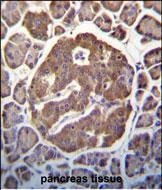MAP3K13 (LZK) Antibody (C-term) (S869)
Affinity Purified Rabbit Polyclonal Antibody (Pab)
- 产品详情
- 实验流程
- 背景知识
Application
| WB, IHC-P, E |
|---|---|
| Primary Accession | O43283 |
| Reactivity | Human |
| Host | Rabbit |
| Clonality | Polyclonal |
| Isotype | Rabbit IgG |
| Calculated MW | 108296 Da |
| Antigen Region | 854-884 aa |
| Gene ID | 9175 |
|---|---|
| Other Names | Mitogen-activated protein kinase kinase kinase 13, Leucine zipper-bearing kinase, Mixed lineage kinase, MLK, MAP3K13 (HGNC:6852) |
| Target/Specificity | This MAP3K13 (LZK) antibody is generated from rabbits immunized with a KLH conjugated synthetic peptide between 854-884 amino acids from the C-terminal region of human MAP3K13 (LZK). |
| Dilution | WB~~1:1000 IHC-P~~1:100~500 E~~Use at an assay dependent concentration. |
| Format | Purified polyclonal antibody supplied in PBS with 0.09% (W/V) sodium azide. This antibody is purified through a protein A column, followed by peptide affinity purification. |
| Storage | Maintain refrigerated at 2-8°C for up to 2 weeks. For long term storage store at -20°C in small aliquots to prevent freeze-thaw cycles. |
| Precautions | MAP3K13 (LZK) Antibody (C-term) (S869) is for research use only and not for use in diagnostic or therapeutic procedures. |
| Name | MAP3K13 (HGNC:6852) |
|---|---|
| Function | Activates the JUN N-terminal pathway through activation of the MAP kinase kinase MAP2K7. Acts synergistically with PRDX3 to regulate the activation of NF-kappa-B in the cytosol. This activation is kinase-dependent and involves activating the IKK complex, the IKBKB- containing complex that phosphorylates inhibitors of NF-kappa-B. |
| Cellular Location | Cytoplasm. Membrane; Peripheral membrane protein |
| Tissue Location | Expressed in the adult brain, liver, placenta and pancreas, with expression strongest in the pancreas |
For Research Use Only. Not For Use In Diagnostic Procedures.
Provided below are standard protocols that you may find useful for product applications.
BACKGROUND
Protein kinases are enzymes that transfer a phosphate group from a phosphate donor, generally the g phosphate of ATP, onto an acceptor amino acid in a substrate protein. By this basic mechanism, protein kinases mediate most of the signal transduction in eukaryotic cells, regulating cellular metabolism, transcription, cell cycle progression, cytoskeletal rearrangement and cell movement, apoptosis, and differentiation. With more than 500 gene products, the protein kinase family is one of the largest families of proteins in eukaryotes. The family has been classified in 8 major groups based on sequence comparison of their tyrosine (PTK) or serine/threonine (STK) kinase catalytic domains. The tyrosine-like kinase (TLK) group consists of 40 tyrosine and serine-threonine kinases such as MLK (mixed-lineage kinase), LISK (LIMK/TESK), IRAK (interleukin-1 receptor-associated kinase), Raf, RIPK (receptor-interacting protein kinase), and STRK (activin and TGF-beta receptors) families.
REFERENCES
Saiga, T. et al. Mol Cell Biol. 2009 July; 29(13): 3529?543. Blume-Jensen P, et al. Nature 2001. 411: 355. Cantrell D, J. Cell Sci. 2001. 114: 1439. Jhiang S Oncogene 2000. 19: 5590. Manning G, et al. Science 2002. 298: 1912. Moller, D, et al. Am. J. Physiol. 1994. 266: C351-C359. Robertson, S. et al. Trends Genet. 2000. 16: 368. Robinson D, et al. Oncogene 2000. 19: 5548. Vanhaesebroeck, B, et al. Biochem. J. 2000. 346: 561.
终于等到您。ABCEPTA(百远生物)抗体产品。
点击下方“我要评价 ”按钮提交您的反馈信息,您的反馈和评价是我们最宝贵的财富之一,
我们将在1-3个工作日内处理您的反馈信息。
如有疑问,联系:0512-88856768 tech-china@abcepta.com.























 癌症的基本特征包括细胞增殖、血管生成、迁移、凋亡逃避机制和细胞永生等。找到癌症发生过程中这些通路的关键标记物和对应的抗体用于检测至关重要。
癌症的基本特征包括细胞增殖、血管生成、迁移、凋亡逃避机制和细胞永生等。找到癌症发生过程中这些通路的关键标记物和对应的抗体用于检测至关重要。 为您推荐一个泛素化位点预测神器——泛素化分析工具,可以为您的蛋白的泛素化位点作出预测和评分。
为您推荐一个泛素化位点预测神器——泛素化分析工具,可以为您的蛋白的泛素化位点作出预测和评分。 细胞自噬受体图形绘图工具为你的蛋白的细胞受体结合位点作出预测和评分,识别结合到自噬通路中的蛋白是非常重要的,便于让我们理解自噬在正常生理、病理过程中的作用,如发育、细胞分化、神经退化性疾病、压力条件下、感染和癌症。
细胞自噬受体图形绘图工具为你的蛋白的细胞受体结合位点作出预测和评分,识别结合到自噬通路中的蛋白是非常重要的,便于让我们理解自噬在正常生理、病理过程中的作用,如发育、细胞分化、神经退化性疾病、压力条件下、感染和癌症。







